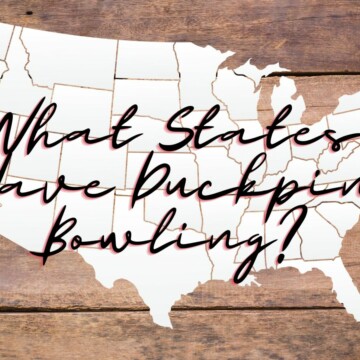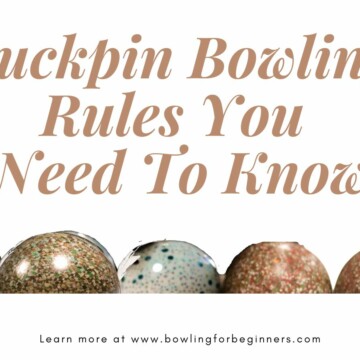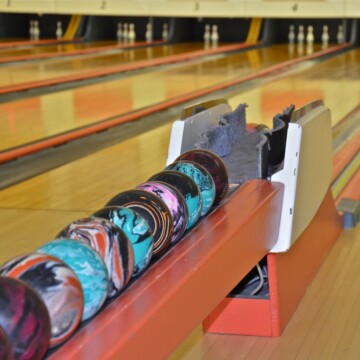
We're putting a spotlight on a lesser-known gem in the realm of bowling — Duckpin Bowling. While traditional bowling might be a familiar pastime for many, Duckpin Bowling brings a whole new level of fun and challenge to the table. Imagine the familiar thunder of pins colliding, the friendly competition, and the joy of rolling that perfect strike, but with a twist.
Duckpin Bowling introduces a unique approach to the beloved sport, providing you with an unforgettable experience. In this post, we'll uncover the history, the rules, and the reasons why Duckpin Bowling deserves a spot on your list of must-try activities.
Contents
- 1 What Is Duckpin Bowling Game?
- 2 Where Did Duckpin Bowling Originate?
- 3 Where Can You Play Duckpin Bowling?
- 4 Why Is It Called Duckpin Bowling?
- 5 How Is Duckpin Bowling Different From Regular Bowling? 5 Different Ways
- 6 Is Duckpin Bowling Harder Than Regular Bowling?
- 7 How to Score in Duckpin Bowling
- 8 How Do You Play Duckpin Bowling?
What Is Duckpin Bowling Game?
Duckpin bowling is a variation of standard 10-pin bowling. It’s played with smaller balls, 10 stocky pins, and different rules, presenting a new set of challenges for bowlers. Duckpin bowling is most popular in the northeastern United States.
Where Did Duckpin Bowling Originate?
Duckpin bowling is thought to have originated in Baltimore, Maryland, around 1900 by two baseball players - Wilbert Robinson and John McGraw. However, lesser quoted but documented Duckpin bowling research reveals that the first documents about Duckpin Bowling can be found as early as the early 1890s in The Boston Daily Globe in Lynn, Mass. Duckpin Bowling Authority is the National Duckpin Bowling Congress (NDBC)
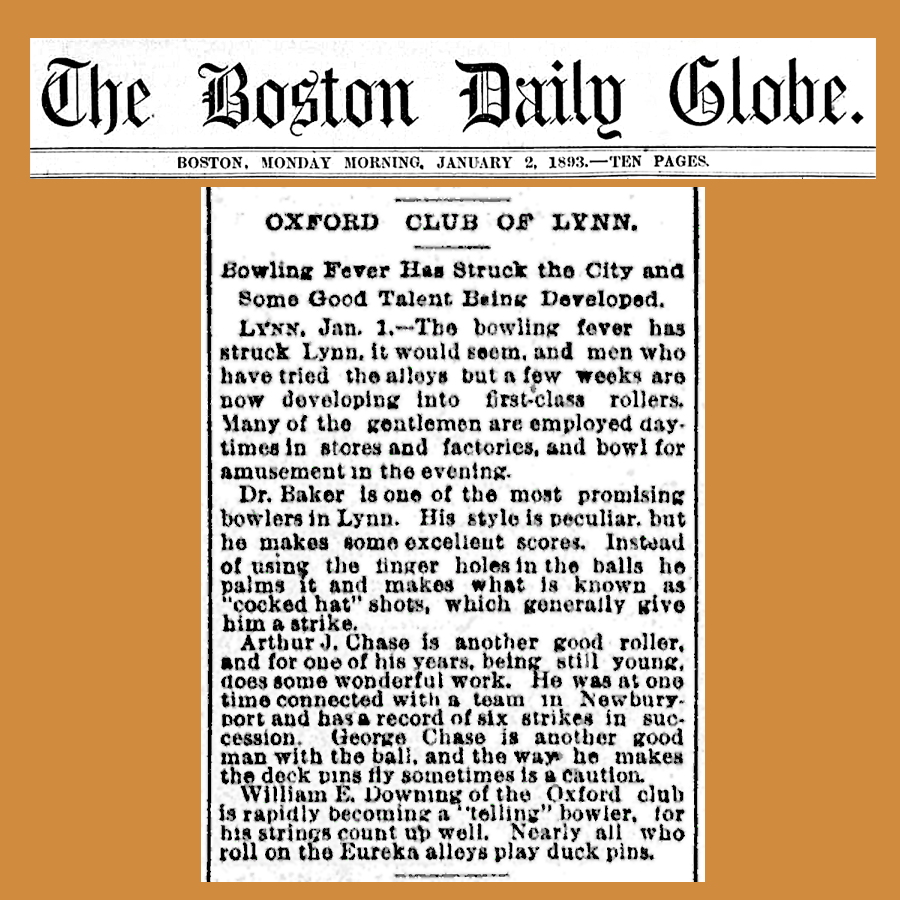
Where Can You Play Duckpin Bowling?
There are about 50 active duckpin bowling alleys in the U.S. along the East Coast. So, if you're looking to play this sport, you may have to do a bit of research to find a duckpin bowling alley in your area.
The Fountain Square Theatre Building in Indiana, Indianapolis, houses one of the most notable duckpin bowling alleys in the country. What differentiates this one from the others is that they have what's called Atomic Bowl, a super fun retro duckpin bowling experience.
Why Is It Called Duckpin Bowling?
Why call it duckpin bowling? The most widely believed story is that the sport was named “duckpin” because the flying pins look like ducks flying away when hit. Given the pins' shorter, more stocky shape, it's easy to see why people might think they resemble ducks.
Others believe that the name comes from how the pins look when they get hit - like ducks wobbling around. Either way, the pins are thought to look similar to ducks - hence, the name.
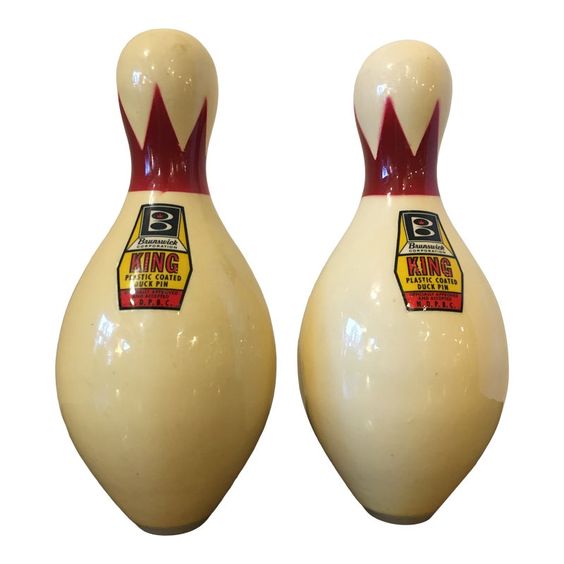
How Is Duckpin Bowling Different From Regular Bowling? 5 Different Ways
Duckpin and Regular Tenpin bowling have similarities. Both sports require you to roll balls down a lane and knock down pins. However, the two sports are very different. Below, we shed light on the most important differences between regular bowling and duckpin bowling:
Ball Size and Weight
One of the most noticeable differences between duckpin and 10-pin bowling lies in the size and weight of the balls used. In duckpin bowling, the balls are notably smaller and lighter, with no finger holes to grip. This contrasts sharply with 10-pin bowling, where the balls are larger, heavier, and usually come with finger holes to help you get a good grip and generate spin.
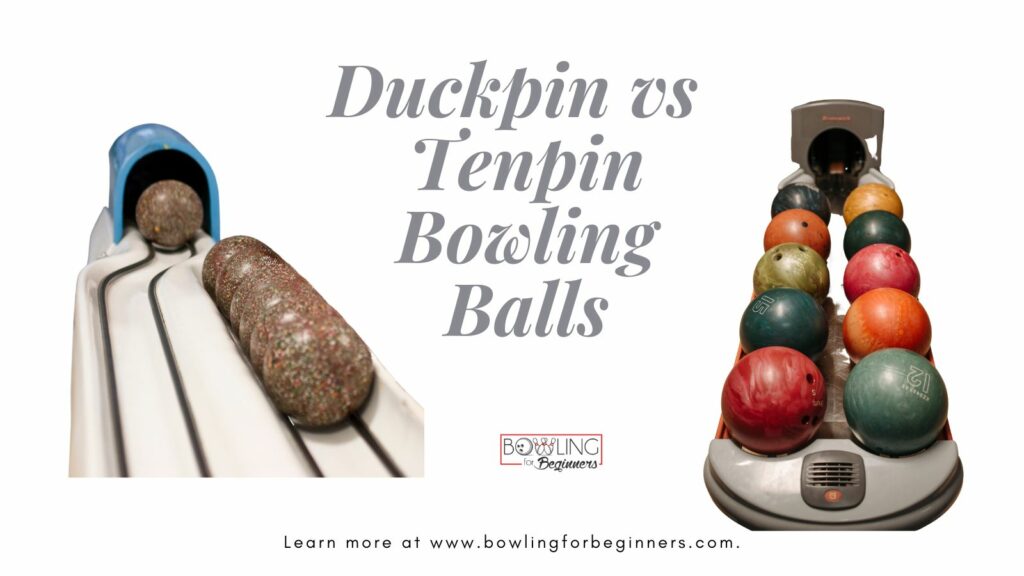
Pins
When it comes to the pins, duckpin features shorter, fatter pins that can be more challenging to knock down. On the other hand, the pins in 10-pin bowling are taller and more slender. The shape and size of the pins in each format significantly impact gameplay.
To learn more about bowling pin weight, height, and more, read this article.

Gutter Size
To accommodate the smaller Duckpin ball, they have smaller gutters. Duck pin gutters are more narrow and not as deep as regular ten pen bowling gutters.
Rolls per Frame
Another distinctive feature is the number of rolls you get per frame. In duckpin bowling, you're given three rolls per frame to knock down as many pins as you can. In contrast, 10-pin bowling limits you to two rolls per frame.
The extra roll in duckpin is a nod to the game's increased difficulty level, giving players an additional chance to improve their score.
Scoring
Duckpin bowlers get three chances to knock down all the pins (and tenpin bowlers get only two chances). Scoring is going to be different for these two games. Strikes, spares, and the last frame of the game are all scored differently.
To learn the ins and outs of scoring for duckpin bowling, read this article in its entirety. It’ll be really helpful for beginners and will even teach you how to score the game yourself.
Strategy
The strategies employed in each type of bowling differ due to the physical differences in equipment. Duckpin bowling is all about precision and finesse, requiring you to be highly accurate with your rolls.
In contrast, 10-pin bowling is often more about power and hook, utilizing the weight and size of the ball to knock down pins more effectively.
Is Duckpin Bowling Harder Than Regular Bowling?
Duckpin is definitely harder than regular bowling, and this is an opinion that’s widely accepted in the bowling world. As the weight of the balls and the size of the pins increases, duckpin bowlers have to be willing to adjust in approach, release, and strategy to score in regular bowling.
Now, this doesn’t mean that anyone should pass on the game; just be prepared to get a lower score than expected if you were playing regular bowling. And it doesn’t just apply to you - it applies to everyone else who plays the bowling variation.
How to Score in Duckpin Bowling
Scoring in duckpin bowling is easy - all you need to do is hit at least one pin with a duckpin bowling ball. If you can stand in the middle of the bowling lane, swing your arm back, and release the ball at about shoulder level, chances are you can score in duckpin bowling.
With that in mind, there’s something that many people do to try for a strike in duckpin bowling, and that’s target the headpin at an angle. This is similar to what bowlers do with ten-pin bowling. It’s important to practice a ton to make this happen; not just any headpin hit will make all the pins fall down.
Now, if you’re trying to achieve a high score in duckpin bowling, there’s something you should know - it’s not easy at all to do so in this bowling variation. You’d need a good bit of practice and strategy to make it happen. And even then, it probably won’t happen in a predictable fashion.
How Do You Play Duckpin Bowling?
Great news, you’ll play it almost like you would regular bowling. But for those who may not be familiar with either sport, here’s how the game will usually go.
- Gather your crew. Round up your favorite people and plan for some serious fun on the lanes.
- Choose a duckpin bowling alley. This step can be difficult, as duckpin bowling availability may be scarce, especially for larger groups, like birthday parties. But if you call around your local bowling alleys and ask them upfront whether duckpin bowling is available and about their lane availability, things can be a little easier and less frustrating. Some bowling alleys have a few duckpin bowling lanes available for those who want to play this bowling variation.
- Rent bowling shoes and a lane, and select a couple of duckpin balls. Don’t be alarmed when you go to the alley and see that the duckpin bowling balls are smaller than you’re used to. That's normal. They’re also lighter and won’t have any finger holes.
- Get set up with the scoring system. Set up your scoring system by inputting your names.
- Get a general understanding of the game structure. Duckpin bowling consists of 10 frames; you get three chances per frame to knock down all the pins.
- Take your position. When it’s your turn, take your position at the start of one of the duckpin lanes. If you’ve bowled before, take a stance that feels comfortable to you. You may want to switch that up a bit depending on the results you get.
- Roll the ball. Roll the ball down the lane with the aim of knocking down as many pins as possible. At the end of the frame, the scoring system will tally your points.
- Take turns. Each player will take turns rolling their balls down the lane and knocking down pins until all the frames are bowled and scored.
Related Articles
So, there you have everything you need to know about duckpin bowling. We hope you found all the information you were looking for, and we wish you the best as you delve into this amazing bowling game. To learn more about bowling in general, check out this article.
Kira Byrd, a Certified Fraud Examiner, holds a B.S. in Accounting from the University of Alabama at Birmingham. With a passion for bowling from her childhood, Kira has poured her expertise and personal experiences into creating and nurturing Bowling For Beginners. Kira's mission is to meet new bowlers where they are and guide them toward consistently achieving higher scores. With a focus on skill development and strategic techniques, she empowers readers to take control of their game and unlock their true potential.
Bowling For Beginners embodies strict editorial integrity, ensuring reliable and unbiased information. Kira's commitment to delivering valuable insights and practical strategies is reflected in every article. Here's an explanation of our editorial policy and how we get money.


